Claire Mabey – 18 September, 2014
The viewing bridge from the title is physically present - placed boldly in the centre of the gallery space. It is a replica of the platform that allows a view of the Chartwell Galleries, and as such re-defines the Athfield architecture of the Adam Art Gallery - from a purpose-built structure for viewing to a structure within which work is made, compiled and played on. The viewing bridge is a prop welcoming us into the world of filmmaking, the anchor for our interaction with the installation.
Wellington
Eddie Clemens
Collector’s Edition Glitch (Viewing Bridge)
15 August - 21 September
“How well I would write if I were not here! If between the white page and the writing of words and stories that take shape and disappear without anyone’s ever writing them there were not interposed that uncomfortable partition which is my person! Style, taste, individual philosophy, subjectivity, cultural background, real experience, psychology, talent, tricks of the trade: all the elements that make what I write recognizable as mine seem to me a cage that restricts my possibilities. If I were only a hand, a severed hand that grasps a pen and writes…who would move this hand? The anonymous throng? The spirit of the times? The collective unconscious? I do not know.”
Italo Calvino, If on a Winter’s Night A Traveller.
“We believe that technology has the power to transform the classroom. It can pave new ways of thinking. New ways of sparking ideas. Yet the foundation never changes: A dedication to learning that’s always been part of our DNA.”
From ‘Apple and Education‘.
––––––—
The relationship between technology and the organic, and the mythology created when those realms are combined, forced, merged, in cahoots or at odds, is at the mechanical heart of Clemens’ work.
iMovie is set up as the ironic champion of Clemens‘ video. Apple is the tool of choice for Clemens who uses it to layer segments of James Cameron films (Titanic, Aliens, Avatar, Terminator) with self-consciously clunky, deliberately messy images of the artist’s own hands making props, images of the inspiration (artist’s work-space with DVD packages), and computer generated interruptions to Cameron’s authorship. The Hollywood studios and their multi-million dollar, unsparingly visually manipulated products are given a homemade makeover in Collector’s Edition Glitch (Viewing Bridge).
The organic is placed back into the process of creating a film, ironically through technology itself. Clemens’ work is a beautifully 90s-rendered reminder of how deeply mechanized visual culture has become and questions where the human now sits in the creation and experience of it. The overt ‘made by Apple by me’ symbols which recur in the video (the Apple packaging itself), the patchwork effect of layering, and the 90s video game aesthetic all de-construct the boundaries between 2-D storytelling and the audience. But before we encounter the video itself, we are invited to re-imagine the space within which we’re watching it.
The viewing bridge from the title is physically present - placed boldly in the centre of the gallery space. It is a replica of the platform that allows a view of the Chartwell Galleries, and as such re-defines the Athfield architecture of the Adam Art Gallery - from a purpose-built structure for viewing to a structure within which work is made, compiled and played on. The viewing bridge is a prop welcoming us into the world of filmmaking, the anchor for our interaction with the installation.
As the projector whirrs from the viewing platform we are taken on a nostalgic journey of James Cameron classics. The platform becomes a mimic of the set for Kate and Leo’s iconic ‘flying’ scene from Titanic and Celine Dion’s music video for the same film. Clemens really digs the gritty, murky truths out of the saccharine smoothness of Cameron’s final products. Nostalgia is quickly turned over to cynicism (though playful) through distortions (Celine’s voice is unrecognizable) and splices of behind-the-scenes (the artist’s hand, painted in hazard stripes, works on a cardboard tube behind Celine’s big moment). Clemens is relentless in his critique of history-cum-entertainment-cum-spinoff.
“This shot was known as the toilet paper scene,” says James Cameron over the top of a shot of an actor clinging for dear life as the Titanic (prop) tips in its final moments above water. Later on in the video, the National Geographic logo hovers prominently on screen over top of a documentary made by the channel and voiced by James Cameron (Titanic 100: New CGI of How Titanic Sank (commentary from James Cameron), National Geographic Published on Apr 5, 2012). The digital image of the Titanic is, in the documentary, reduced to a computer-generated analysis of a disaster communicated to viewers by a filmmaker who is passionate about creating and portraying the historical destruction on screen, as entertainment. Clemens’ juxtapositions are deceptively provocative.
Collector’s Edition Glitch (Viewing Bridge) can be seen as an artist requesting viewers to re-consider the central relevance of mass visual culture today. Has technology - mechanized storytelling - replaced or even entirely removed the spirit of the story? The National Geographic logo brings to mind a view of an African plain, deep sea creatures, blue whales - iconic natural life on earth as explored by documentary film makers. However, in this film Clemens shows us the Titanic as created digitally, a purely fictional manifestation of fact rendered to trace the Titanic disaster, step-by-step. The enthusiasm for which the voice over (Cameron) narrates the imagery evokes something terribly crass. The director’s passion for the possibilities of technology and the worlds that can be created through it overwhelm the human essence of the story here - the loss of life, the tragedy that is left when all of computer images and overblown imaginings are taken away.
This idea of the uncertain place of the natural and the organic in film is further illuminated by a sequence of scenes (from 4.22) involving the haka. Scenes from Aliens play out behind footage of a haka performed by some of the New Zealand cast and crew of Avatar. Snippets from a behind-the-scenes interview with Cameron explains, “this was their way of saying New Zealand thanks you for bringing the project to New Zealand and letting us be part of it, and it was a very, very emotional moment.” The scene then cuts back to Sigourney Weaver in the depths of Alien interaction; we are hurriedly moved on by Clemens and swept back up in the nostalgia of a visual culture icon. This haka/gift sequence is a nod to the New Zealand film industry (and possibly to the controversy that has surrounded it in recent years, in relation to Hollywood-spurred changes to Employment Law); but it is also an insight into the human side of the filmmaking process and the individuality that still remains behind camera. Clemens throws us back and forth, and awkwardly in between, the human back-end and the inhuman final products.
The dominant images in the latter half of the video are of the clumsy iMovie maker, and a manipulated version of the Titanic documentary. White Apple packaging floats in its brown delivery box, tied with red ribbon, like a spectral present. The artist’s own hands work at the white boxes, clumsily and laboriously taping them to piping with copious gaff tape. It’s awkward, amusing and ugly. With none of the Hollywood gloss and chic, this is amateur movie-making revealing (literally) the hand of the artist, the auteur.
Perhaps this is the heart of Collector’s Edition Glitch (Viewing Bridge): who is the auteur? Human, director, artist? Or technology, mechanical process, the cyborg? Just as James Cameron manipulates history and forces visual culture to commemorate the Titanic through popular culture, Eddie Clemens manipulates and disrupts Cameron’s attempt at fact: Clemens splices a gloopy hazard-lined form over top of the National Geographic Titanic documentary. The disruption is the artist’s mechanical stamp on National Geographic, on James Cameron, on the confused boundaries between Titanic the movie and Titanic the historical event. It is technological genetic engineering - made possible by Apple technology and wielded by the artist at home, reminding us all that we have the tools to tamper with visual culture.
Claire Mabey
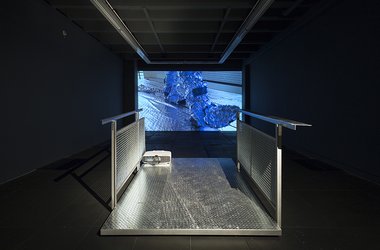
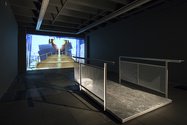
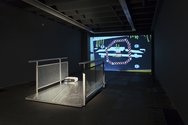
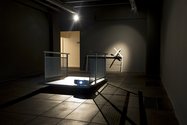
 Advertising in this column
Advertising in this column Two Rooms presents a program of residencies and projects
Two Rooms presents a program of residencies and projects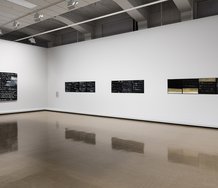
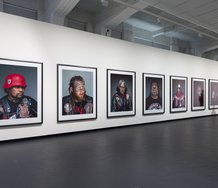
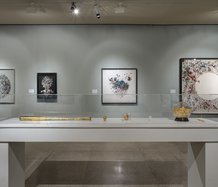

This Discussion has 0 comments.
Comment
Participate
Register to Participate.
Sign in
Sign in to an existing account.